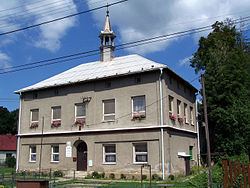Elevation 420 m (1,380 ft) Area 15.45 km² Local time Monday 3:35 AM | First mentioned 1466 Postal code 739 84 Population 1,779 (2006) | |
 | ||
Weather 6°C, Wind W at 19 km/h, 93% Humidity | ||
Písek (Polish: Piosek ) (literally "sand") is a village in Frýdek-Místek District, Moravian-Silesian Region of the Czech Republic. It has 1,783 inhabitants (2001 Census), 21% of the population are the Poles. It lies in the Silesian Beskids mountain range, in the historical region of Cieszyn Silesia. Olza River flows through the village. A road linking the Polish village of Istebna with Jablunkov runs through the village.
Contents
Map of 739 84 P%C3%ADsek, Czechia
The name of the village is of topographic origins derived from sand (piasek in Polish, piosek in a local dialect). Historically it has been scribed as Piesek (1523), Pisek (1577, 1621), Pyßek/Pioßek (1643), Piasek (1652) and so on.
History
Piosek was established most probably in the 14th century. Historians presume that on the basis of establishment date of nearby Bukowiec (1353). The village was first attested in a written document in 1466 where a local vogt was mentioned as foytowi Piseczkemu. Politically the village belonged initially to the Duchy of Teschen, a fee of the Kingdom of Bohemia, which after 1526 became part of the Habsburg Monarchy.
In the 14th and 15th centuries villagers lived mainly off simple farming, pastures and forest work. As a result of Thirty Years' War number of farms, farmers, millers etc. dropped. After the establishment of Třinec Iron and Steel Works in 1839 many inhabitants of the village went there to work as a workers.
After Revolutions of 1848 in the Austrian Empire a modern municipal division was introduced in the re-established Austrian Silesia. The village as a municipality was subscribed to the political district of Teschen and the legal district of Jablunkau. According to the censuses conducted in 1880, 1890, 1900 and 1910 the population of the municipality grew from 884 in 1880 to 1,055 in 1910 with a majority being native Polish-speakers (dropping from 100% in 1880 to 97.5% in 1910) accompanied by German-speaking (at most 26 or 2.5% in 1910) and Czech-speaking people (at most 21 or 1.1% in 1910). In terms of religion in 1910 the majority were Roman Catholics (59.5%), followed by Protestants (40.5%). The village was also traditionally inhabited by Silesian Gorals, speaking Jablunkov dialect.
After World War I, fall of Austria-Hungary, Polish–Czechoslovak War and the division of Cieszyn Silesia in 1920, it became a part of Czechoslovakia. Following the Munich Agreement, in October 1938 together with the Zaolzie region it was annexed by Poland, administratively adjoined to Cieszyn County of Silesian Voivodeship. It was then annexed by Nazi Germany at the beginning of World War II. After the war it was restored to Czechoslovakia.
From 1975 to 1990 the village was administratively a part of Jablunkov.
Religion
The majority of population are religious, most of which are Roman Catholics. There is a Catholic church in the village and a SCEAV Lutheran church consecrated in 2010.
